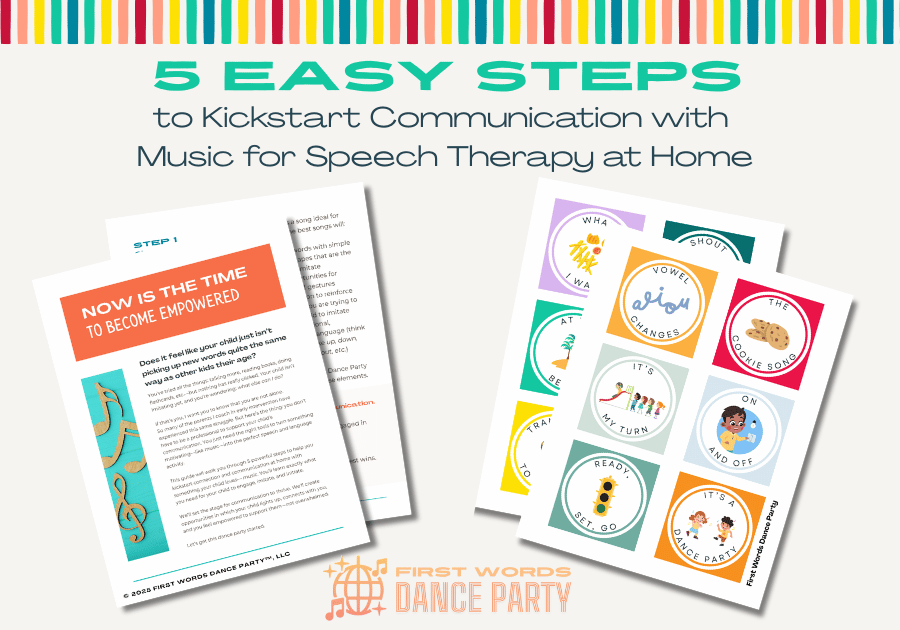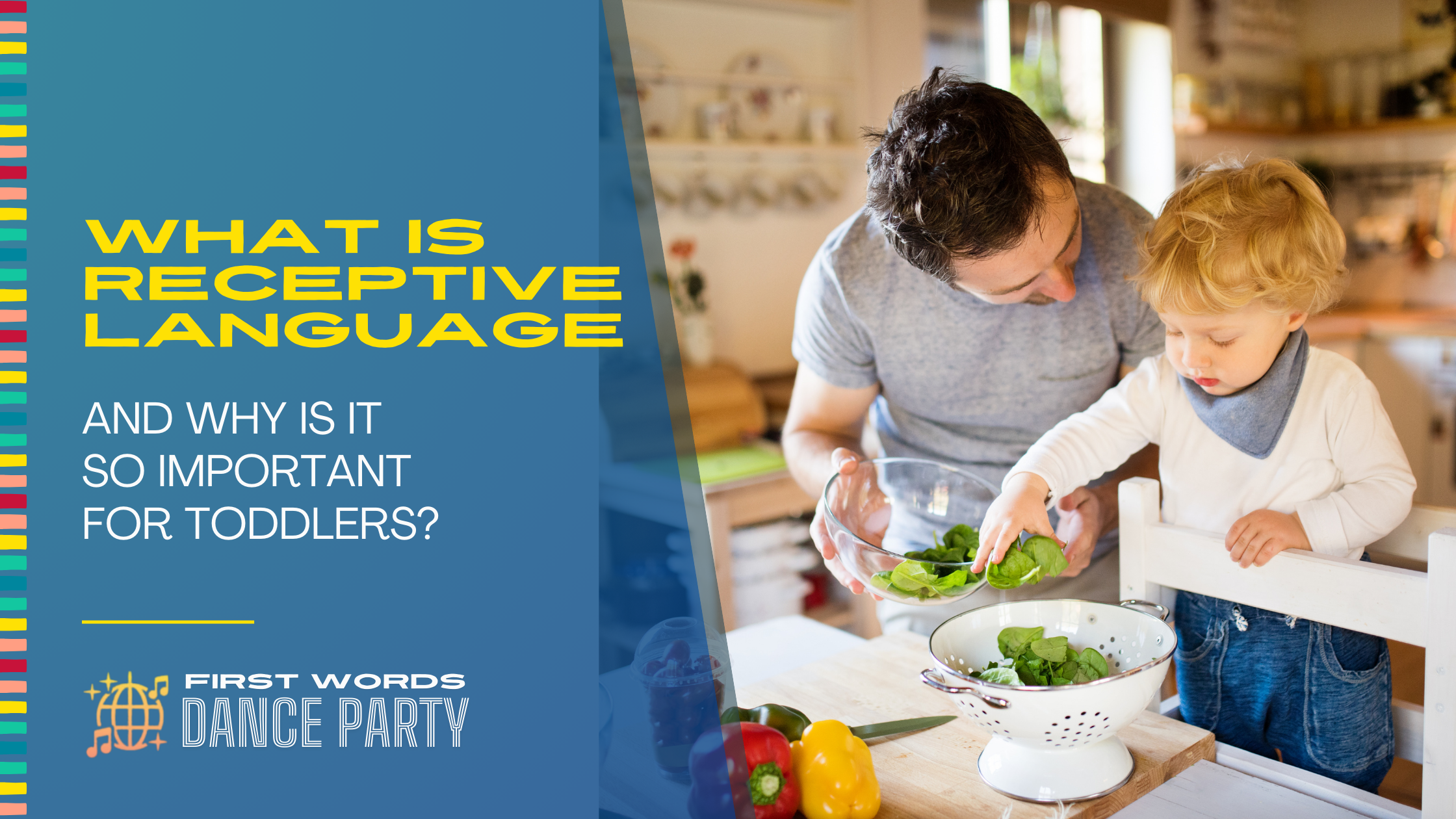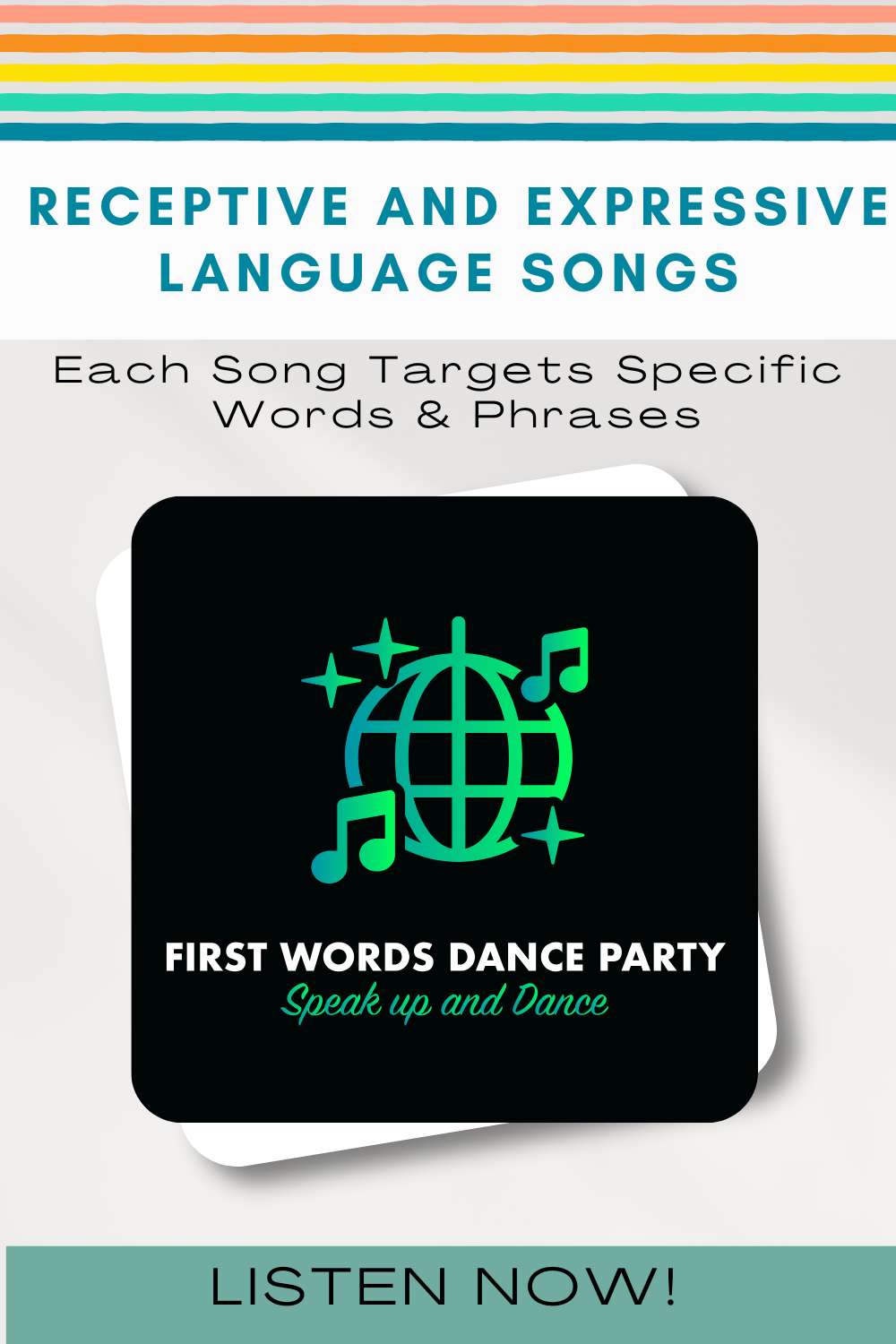Receptive Expressive Language Disorder: 3 Solutions You'll Need to Overcome Strong Behaviors
- 0 comments
If your child has a receptive expressive language disorder, you have likely run into some struggles with challenging behaviors. Challenging behaviors are common among children struggling to understand and use language.
As an early interventionist who coaches the parents of toddlers with receptive and expressive language delays, behavior is one of my favorite things to address with parents.
This probably sounds crazy. You might be thinking, “How could anyone enjoy talking about behavior?”.
I like talking about behavior with parents because it impacts the whole family unit. Addressing the problem with the right support is a pretty awesome feeling.
If your child is struggling with understanding directions and other things you say, or if your child has a speech delay, then this post is for you. Read on for tried and true strategies you can start using today to start solving those communication breakdowns and baffling behaviors at home.
If your child isn’t using many words yet, you may be unsure of what to do and what notto do- and you’re not alone. Many parents I coach in early intervention feel stuck, frustrated, or overwhelmed when their child won’t imitate their words.
That’s why I started creating music for speech therapy that weaves in the strategies we use everyday in early intervention.
You can download a free guide to discover 5 easy, parent-friendly steps to use songs for speech therapy to spark connection and communication with your child. As a bonus, you’ll receive song boards with cards for every First Words Dance Party™ song, so your child can make choices and initiate.
Ok, now on with how to tackle those challenging behaviors.
Common behaviors among children with language disorders
The parents I work with are often struggling with the same kinds of behaviors: when they give their child a direction, the kiddo just doesn’t respond.
When it’s time to transition from one activity to another, a meltdown follows.
When the parent asks the child a question about what they want or need, the child doesn’t answer.
When they prompt the child to imitate the name of something, they don’t respond.
Sometimes children are so frustrated that they hit others or themselves, or use other physical means to express themselves.
Do any of these sound familiar?

Parents are their children’s most influential communication partners
So what’s a parent to do? Over the years, I’ve worked with many parents struggling with the same kinds of challenges- and finding solutions together never gets any less rewarding.
There are small changes you can make to the things you are already doing that will have profound impacts on your child’s ability to understand and communicate better with you across the day.
Communication is, after all, the hallmark struggle for kids with receptive expressive language disorder. So when we make small changes to the way that we communicate with our children, then their communication skills improve.
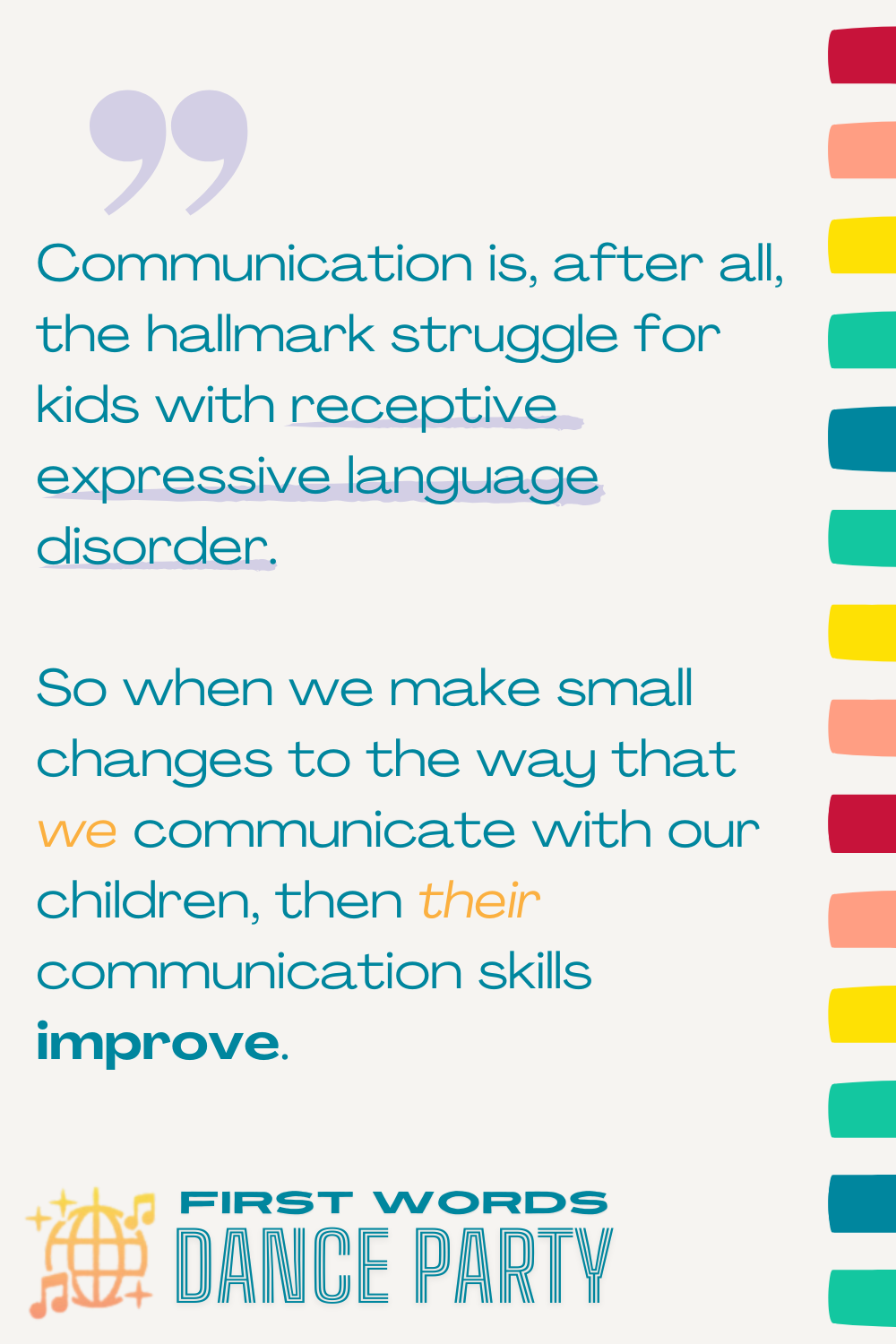
Read this if you’re wondering, ‘What is receptive expressive language disorder?”
Receptive expressive language disorder is also referred to as mixed receptive and expressive language disorder, mixed expressive and receptive language disorder, and expressive receptive language disorder. This communication disorder involves significant delays in the areas of both receptive language and expressive language.
What is receptive language?
A receptive language definition is simply the understanding of language. For toddlers, receptive language milestones include: following directions, understanding the names of objects and people, identifying body parts and clothing, and pointing to pictures in a book when an adult labels them.
For more in-depth information on how to support your child's receptive language development, you can check out this article:
What is expressive language?
Expressive language refers to the words and phrases that a child can say. For toddlers, this includes the ability to express their wants, needs, and other functions. It involves the ability to use words as symbols that represent concepts- for example, that when you string together the three different sounds in the word “ball”, that sound sequence is a symbol for the round object that bounces and rolls across the floor.
Why do kids with receptive expressive language disorder struggle with behavior?
Children can have a receptive language disorder or an expressive language disorder independently of each other. Children diagnosed with receptive expressive language disorder, however, have difficulty with both aspects of language.
With delays in the areas of both expressive and receptive language, little ones with receptive expressive language disorder often struggle to understand what is happening around them. They also struggle to use language to express themselves and to let others know what they need.
With these significant challenges, it’s no wonder why these children may demonstrate challenging behaviors.
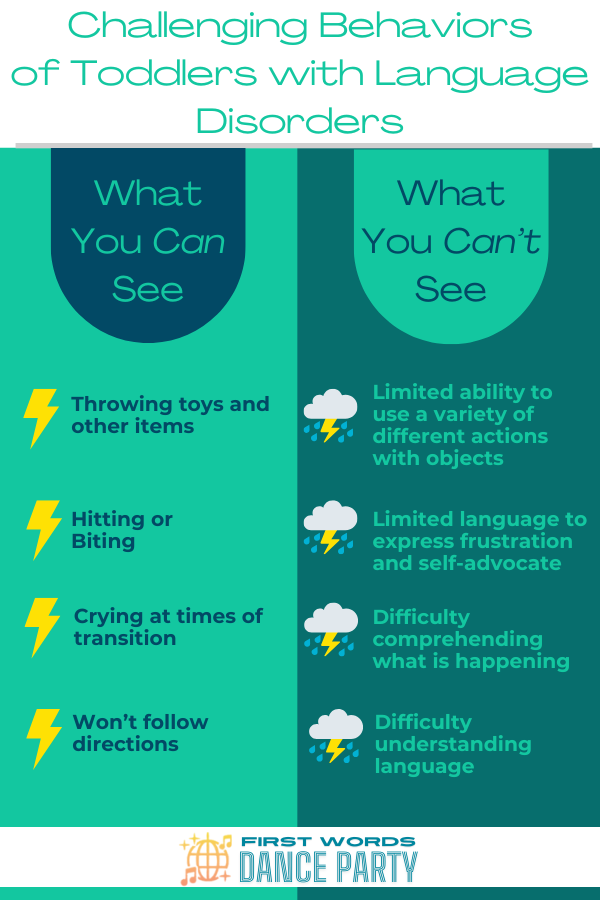
The most important thing to understand about behavior
The single most important thing to understand when addressing any behavior is to acknowledge that behavior is a form of communication.
Children with language delays often use behavior to communicate because it is very effective, and they lack other means of getting their message across.
When our children have big behaviors, the one thing we have to ask ourselves is, “What is my child trying to tell me?”.

To answer this question, we first have to think about the antecedents to the behavior, or the thing(s) that happen just before the behavior occurs.
How to determine what a child is trying to tell you with their behavior
Let’s consider an example.
Say that a child is playing with cars. The parent is enjoying a few minutes of precious downtime and suddenly notices it’s a little past the typical time to start the bedtime routine. So the parent tells the child that it is time to go upstairs and take a bath, and then the parent begins cleaning up the cars.
The child responds by shouting, crying, and hitting the parent. The parent responds by telling the child to stop, and then asks “Do you want to take a bath?”
In this relatable example, the behavior is easy to identify: the behavior is shouting, crying, and hitting.
The antecedent (the thing that happened before the behavior occurred) was that the parent announced that it was time for a bath and then began cleaning up the cars.
So when we think about both the antecedent and the behavior together, what do you think the child was trying to say with their behavior?
Likely the child was trying to say something along the lines of: “Hey! What are you doing?!? I am in the middle of something here. I’m SO frustrated that you just started cleaning up my stuff without even consulting me!”
Obviously, toddlers don’t have the language to communicate like this. And a toddler with receptive expressive language disorder is behind their same-aged peers in their ability to communicate.
A toddler with a speech delay has relatively few words to try to relay any of those feelings to their parent. That toddler also doesn’t have the receptive language to think through their feelings with that kind of inner dialogue.
What these toddlers do have are strong feelings and lots of them. But, they don’t have the brainpower yet to manage their impulsivity.
So now, we can gain a clearer understanding and empathy for the dissonance a child must feel when they have these strong emotions and little language through which to make sense of those feelings bubbling inside.
Now, don’t fret. There are highly effective strategies you can start using today to start working through those challenging behaviors.
How to solve challenging behaviors when your child has delays in expressive and receptive language
Now that we’ve established that behavior is a form of communication, we can use it to our benefit. We can use this as a lens to make sense of common but challenging behaviors.
With the knowledge that behavior is actually a form of communication, we can get away from common misperceptions, like the belief that a child is being naughty, spoiled, or lazy, in order to make way for solutions that work.
How to help a child with a receptive language delay follow directions
The parents of the toddlers I work with are often struggling to get their children to follow simple directions like, “Go get your cup”. It makes sense why following directions is such a struggle for these little ones when you first consider that understanding the names of objects and following basic directions are foundational receptive language skills.
They often just don’t understand the actual words within the direction that are being spoken to them. And, if and when they have some emerging understanding, if the child’s attention is on something else, like a favorite toy or a show at the time the direction is being given, they are much less likely to shift their attention to process that language.
To support these kiddos with following directions, we turn to visuals to help us.
What do I mean by visuals? I mean objects, pictures, and even gestures and sign language to add a visual component to the direction.
Let’s go back to our example above of the toddler who cried and hit their parent when it was time to clean up.
The direction given to the child in that scenario was that it was “time to go upstairs and take a bath”. This direction may have gone much better if the parent had added a visual to help the child understand what was going to happen next.
The parent could go get the child’s favorite bath toy and show it to the child. The parent could also simplify the direction from “It is time to go upstairs and take a bath,” to just, “Bath time” or “Time for bath.”
It would also be incredibly beneficial to give the child extra time after the direction to process what was said before shifting gears into bathtime.
Whenever possible, try to incorporate visuals when giving directions- especially at times of transition. This is a proactive strategy that will help to ensure that your child understands what is about to happen next before things start changing.

Pro Tip for Receptive Language Skills
Here is a pro tip for helping your child follow other directions during self-care, meals, play, and other activities: start by focusing on directions in which you ask your child to put something in as part of the instruction. Here are some examples:
Throwing trash away
Putting clothes into a hamper
Placing a cup or dish into the sink
Placing bath toys into the tub
Placing laundry into the washing machine
The reason this works so well as a starting point is that taking items in and out is one of the first actions with objects that little ones tend to use.
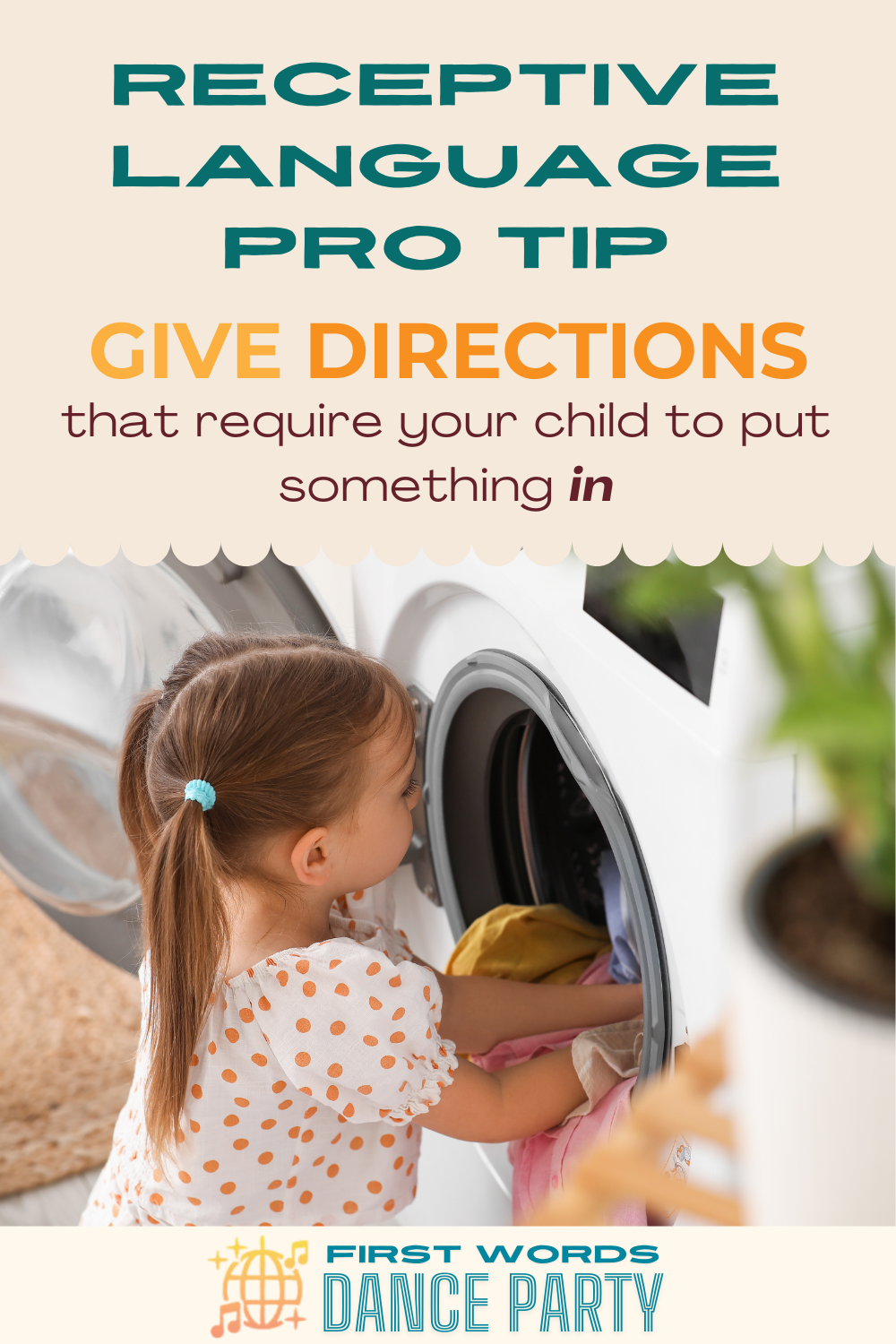
Children have to imitate a variety of different actions with objects before they are ready to imitate higher-level skills like gestures, sounds, and words. So when you have your child help with simple household activities like these, you are also helping them with their expressive communication, too. Win-win!
How to help a child with receptive and expressive language delays to express their wants and needs
Children with receptive expressive language disorder often become frustrated when they are unable to share their basic wants and needs with others. Throwing, crying or screaming, climbing, and other challenging behaviors often crop up when kids just don’t have another way of sharing these messages with others.
To help children express these needs, it’s important to meet children where they are- and they might not yet have the foundational skills to imitate verbally.
In addition to using actions with objects, little ones have to be able to imitate gestures before they can imitate words. This is why modeling sign language and gestures is so beneficial for little ones who are struggling to communicate.
I’ve worked with many parents and childcare providers who are nervous that if they use sign language, then their child won’t be motivated to talk. Not to worry! Research has demonstrated that sign language increases a child’s verbal imitation skills- not the opposite. So sign away!
Here are my all-time favorite signs to model to toddlers to decrease frustration and challenging behavior:
Eat
Milk
More
All done
Help
Open
Stop
Go
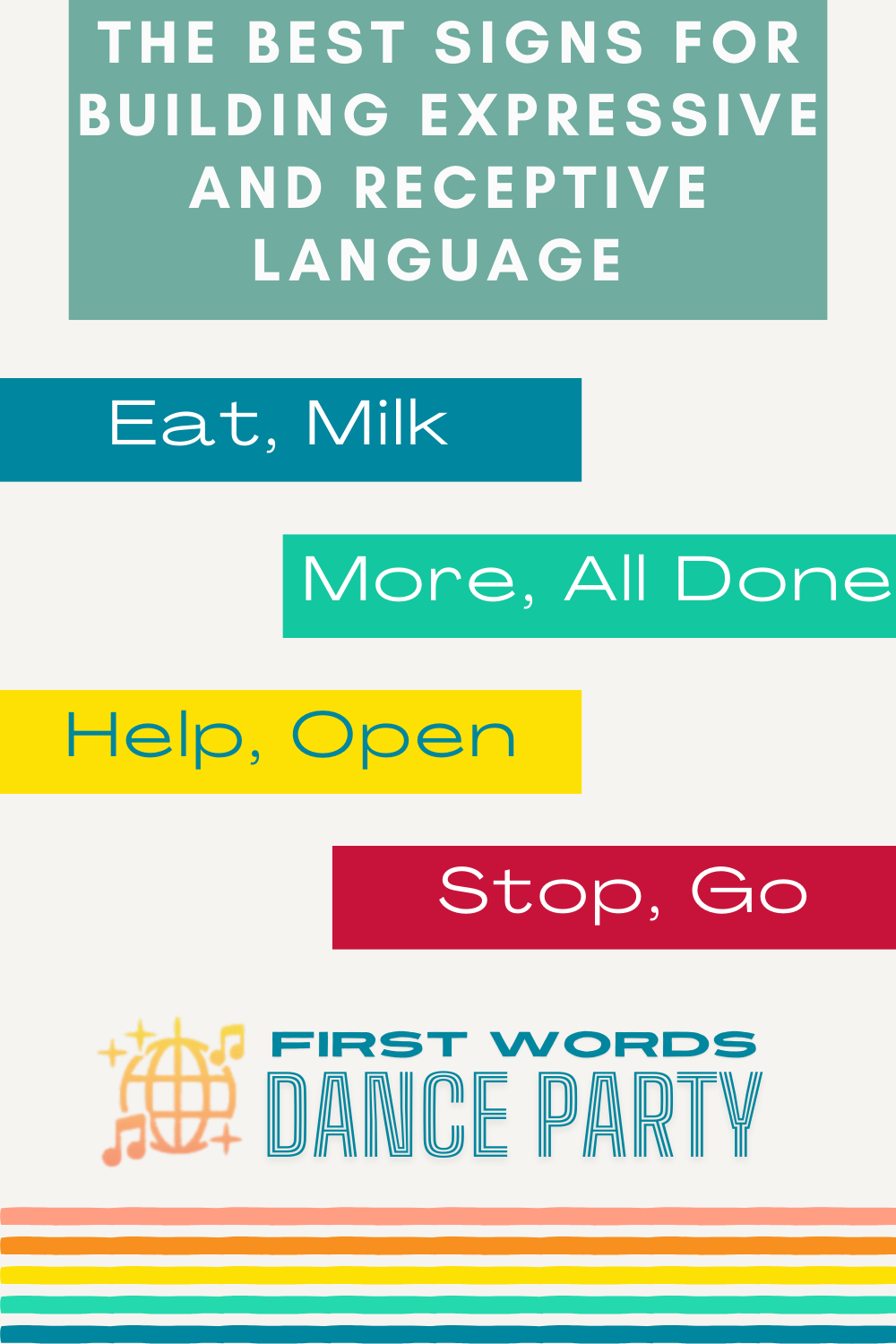
Don’t forget about gestures! Which of these gestures is your child using? Are there any you could start sprinkling into playtime and other activities so that your child has the opportunity to imitate you?
Waving hi and bye
Ta Da! (Arms up high)
So Big! ("How big is JJ? SO BIG!" with arms up high)
Where are you? (or Where did it go?)
Blowing a kiss
Clapping
Actions in songs like “Wheels on the Bus” and “Itsy Bitsy”
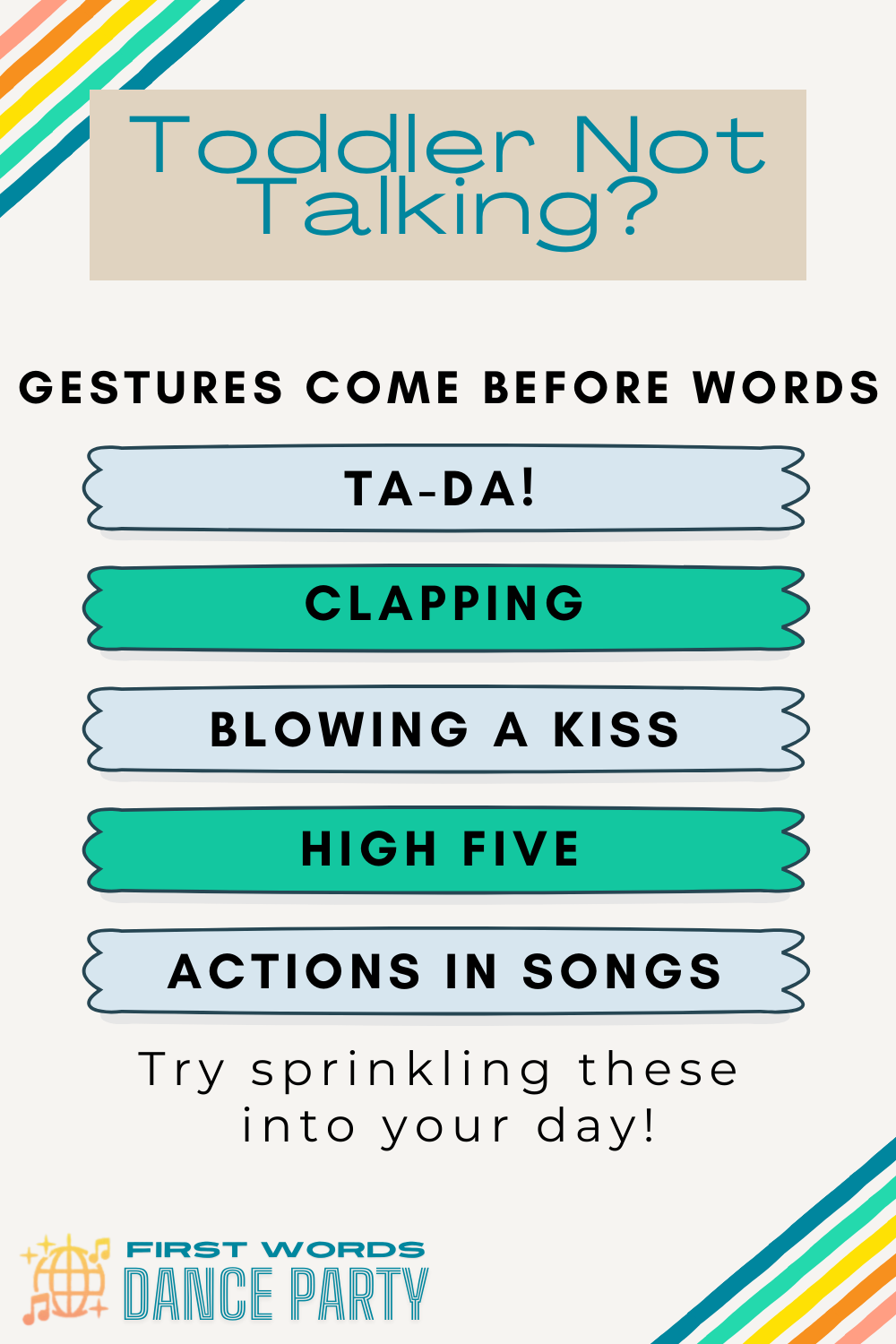
Check out the 16x16 series from the First Words Project for free, beautiful printouts of 16 Actions with Objects and 16 Gestures by 16 Months. They’ll help you figure out which skills your child is already doing and get you thinking about which ones to focus on next.
Sometimes kids throw toys and other objects when they have limited play skills, and they don’t yet use a variety of other actions with objects. It’s worth taking the time to consider which actions with objects you could spend some time modeling to your child as you play and go about your daily routines in order to cut down on throwing.
Instead of Asking Questions, Make Comments
When you ask your child a question like, “What do you want?” or “What is that?”, what usually happens next? Do they answer? Or do you end up following up with another question or prompt?
One of the biggest ruts we get into as parents is to ask too many questions. What usually happens is that little ones start to process the question we just asked, but then when they don’t respond right away, we fill the silence with another question.
Don’t feel guilty. We all do it. Sometimes it feels a little challenging with all these one-sided conversations, am I right?
So here’s the solution: comment, comment, comment.
Every time you’re tempted to ask, “Is that a cow?” just label it by saying “Cow”.
Instead of “What color is it?”, say, “A red apple.”
Instead of, “What do you want?” or “Do you want milk?” when the child shoves their empty cup into your hand, say, “You want milk.” (Bonus- sign “milk” while you say it!).
Comments are processed faster and more easily than questions, and they offer much richer language models. So, when your goal is to help your child to talk and understand more, you’ll get SO much more bang for your buck with comments than you will with questions.
For more tips on how you can help your child talk by providing better language models, check out this article.
Avoid Prompts
On a related note, prompting your child has the same effect as questions. So instead of prompting your child by saying things like, “Say ‘more’ ” or “Can you say ‘more’?”, just model the word “more” and sign it instead.
Modeling instead of prompting takes the pressure off, resulting in a much more natural, back-and-forth interaction that offers more language and turn-taking.
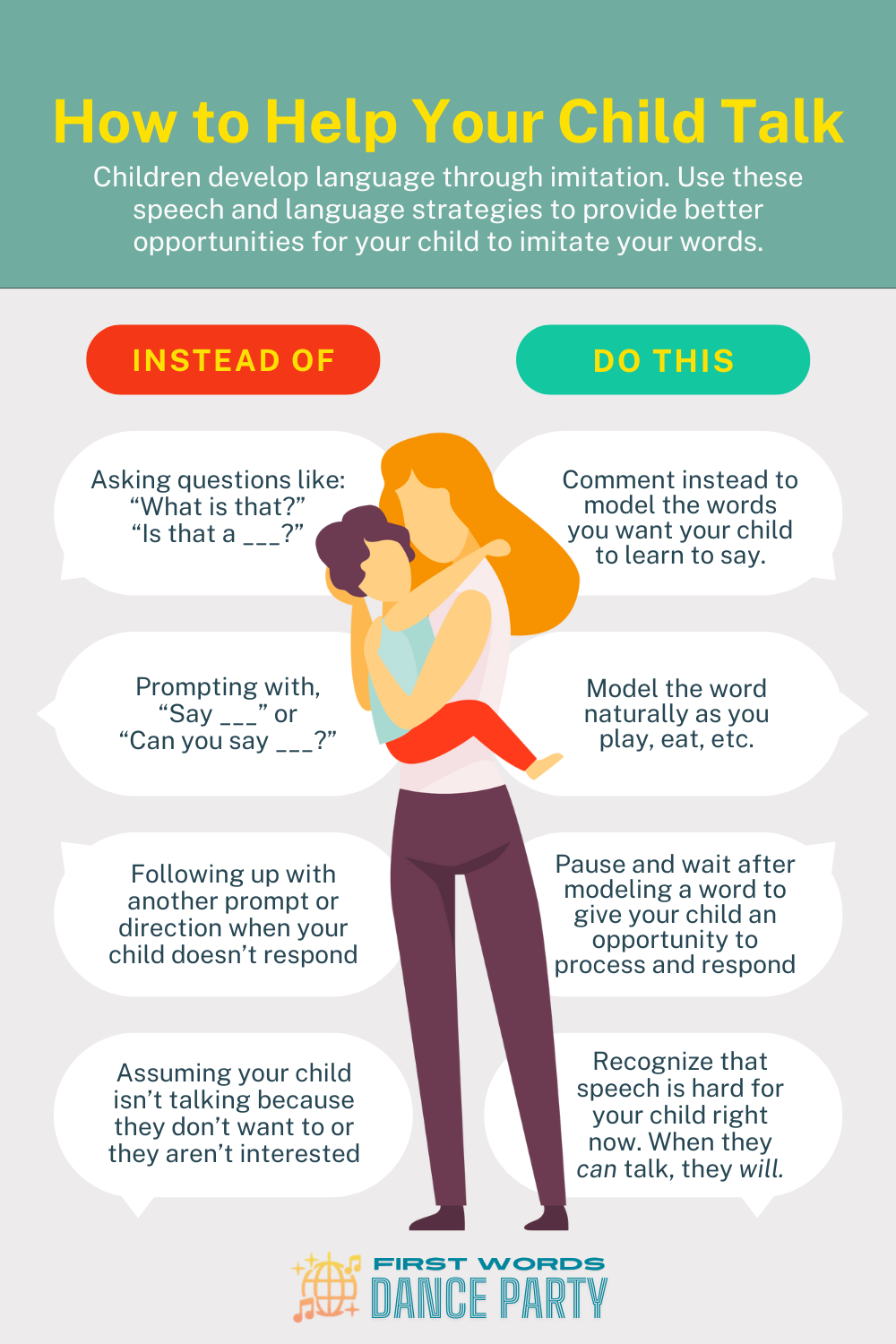
More resources for expressive and receptive language development
If you’ve been thinking about trying some signs with your little one but you’re not quite sure how to start, head over to Baby Sign Language. You’ll find a dictionary of pictures and videos for just about any word you need, as well as helpful tips and videos to get you started.
Kids with receptive and expressive language delays thrive when they have access to visuals. Earlier in this article, we talked about how to use actual objects, gestures, and signs as visuals, but visuals can also include pictures.
Pictures can be used as a bridge to help children communicate their messages to others, alleviating tons of frustration for both parents and children. Visuals can also be used to break down directions, like the steps needed to get ready for childcare, and for schedules to help a child anticipate what their morning will look like.
Head over to Autism Little Learners for a free starter pack of visuals you can start using with your little one.
Strategies for kids with delays in expressive and receptive language development who are music lovers
Does your child love music?
First Words Dance Party capitalizes on the motivational nature of music with songs for speech therapy that model highly functional words with the earliest developing sounds and syllable shapes.
First Words Dance Party brings speech therapy and music together with fun, catchy songs that are just as enjoyable for adults as they are for children. This makes it possible for you to help your child with their expressive and receptive language development anytime you listen and sing along.
Songs for speech therapy everyone can enjoy
These catchy songs provide functional words and phrases that are perfect for imitation.
Here are a few examples:
The Cookie Song: What first seems like a cute song about every kid’s favorite dessert is actually a dance-y little number that targets the first words yes, no, eat, mommy, daddy, doggie, and of course… cookie! This one is perfect for kiddos who aren’t yet saying “yes” and “no”.
It's My Turn: Another fan favorite. This fun song about sharing helps toddlers and children with speech delays learn the words necessary to ask others for a turn.
“Ready, Set, Go”: A super fun little number that draws on a powerful strategy to build anticipation. Check out the core word lyrics video below to see how this tiny but mighty word in action.
You can stream First Words Dance Party on Spotify, YouTube Music, Apple Music, and anywhere else you get your music.
How to extend the magic from the songs to your child's daily routines
If you’ve ever felt the weight of trying to support your child’s speech progress at home—wondering “Where do I even start?” or feeling like the things you have tried just haven’t been successful—you’re absolutely not alone. Trying to navigate speech therapy home activities that feel meaningful and manageable (rather than another exhausting to‑do) can leave you drained, second‑guessing, and wishing for something simpler.
That’s where the Homeschool Speech Therapy Handbook comes in. Designed specifically for parents (not trained therapists) who want real‑life tools, this guide breaks down exactly what to do, why it works, and how to bring speech‑therapy practice into everyday moments—snack time, bath time, play time—without turning your home into a clinic.
Framed within a song-by-song breakdown of the Speak up and Dance album, you’ll discover how to apply the strategies within each song to real life for easy speech therapy practice at home. You’ll move from feeling overwhelmed and unsure to feeling confident and connected—watching your child engage, communicate, and grow in ways that feel easy and natural.
Final Thoughts
Parenting a toddler is hard work. It’s a thankless job that is messy, loud, and keeps you working 24 hours a day, 7 days a week.
While tantrums are typical for this age, children with receptive expressive language disorder often have more challenging behaviors. They may cry, yell, and use physical means to express themselves more frequently than their same-aged peers due to challenges with understanding and using language.
Reframing that behavior to see it as a means of communication can help tremendously. When we ask ourselves, “What is my child trying to tell me with this behavior?”, we gain valuable insight that can help us to figure out how to solve the problem.
Before you go prep the fifth snack of the day or clean up the toy room, don't forget grab your free download: 5 Easy Steps to Kickstart Communication with Music for Speech Therapy at Home.
Parents are a child's most influential communication partners, so no one is better suited than you to help your child with their communication.
I hope that the tips in this article have given you some practical ideas that you can use to reduce your child’s challenging behaviors.
Having a child with a receptive expressive language disorder can be hard work, but with the right tools to support you and your child, you’ve got this!
